- After reading Part A: What conclusions can you draw from the Tiny Prints case regarding the pros and cons of bootstrapping a startup? Please be sure to support your conclusions with specific examples from the case.
- After reading Part B: If you were a member of the Tiny Prints founding team, what course of action would you want the team to take with regard to being acquired? What are the reasons for your recommendation?
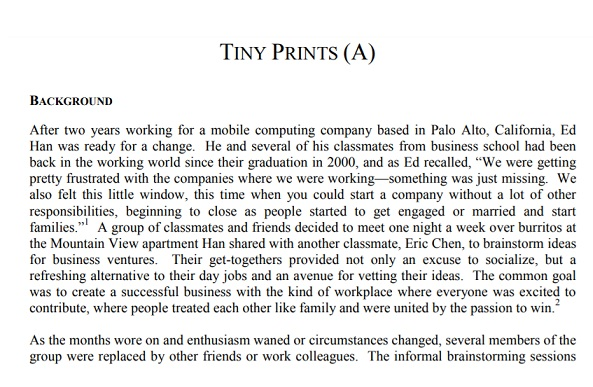
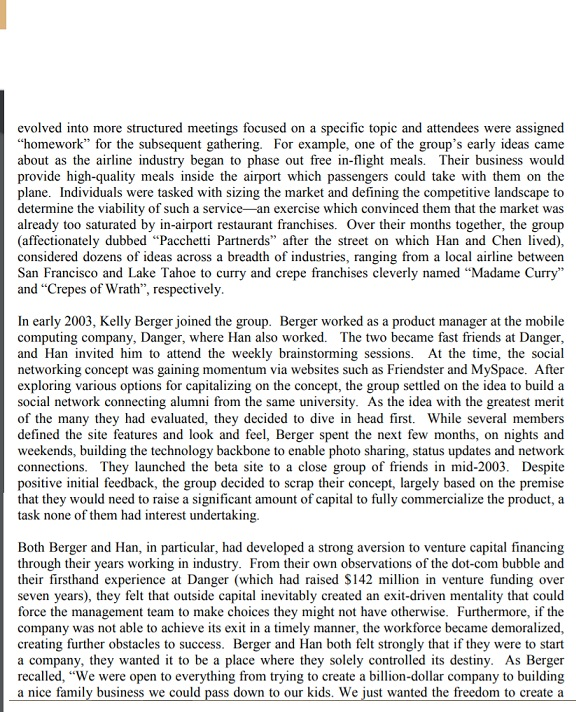
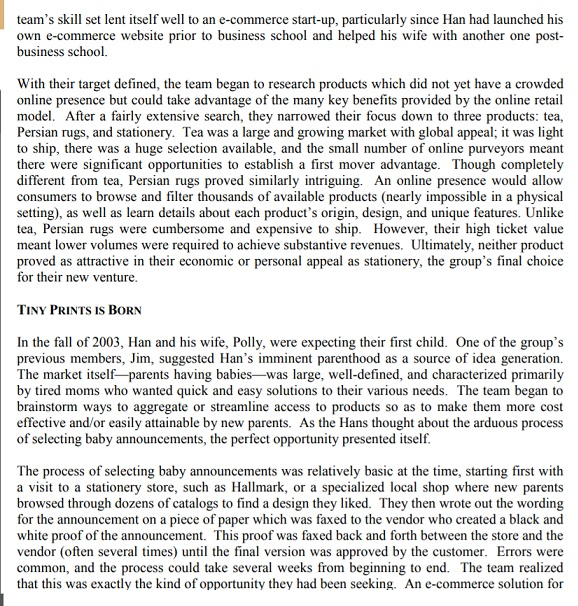
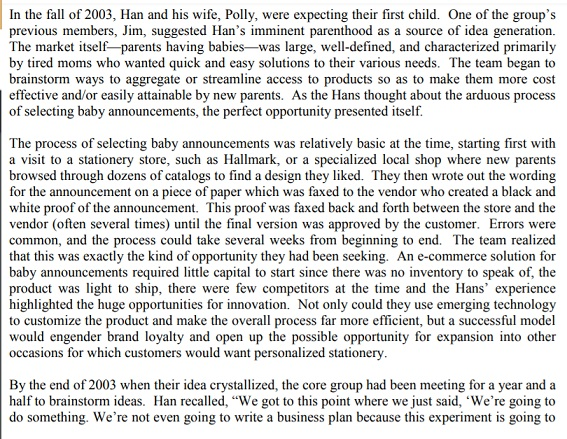
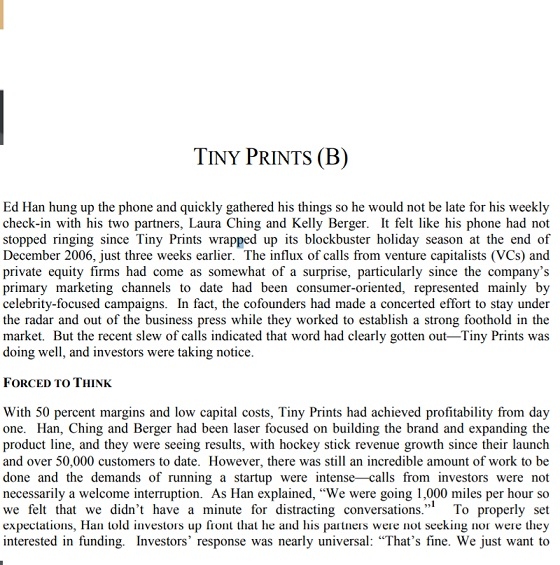
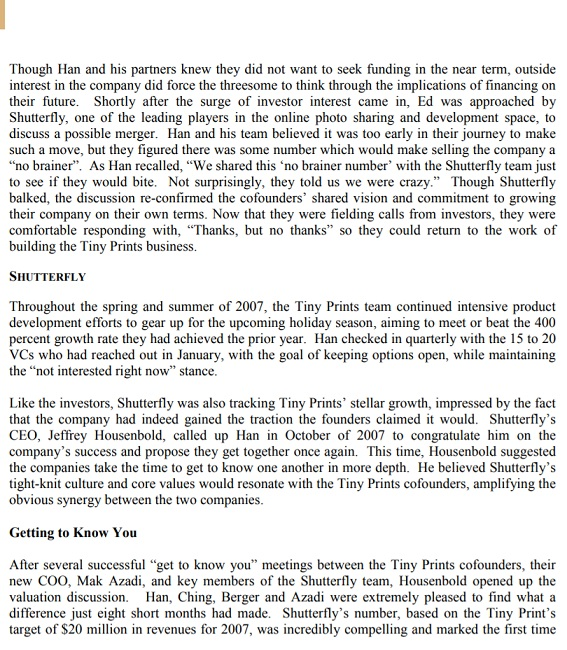
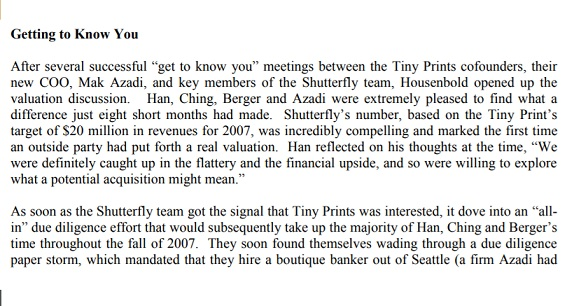


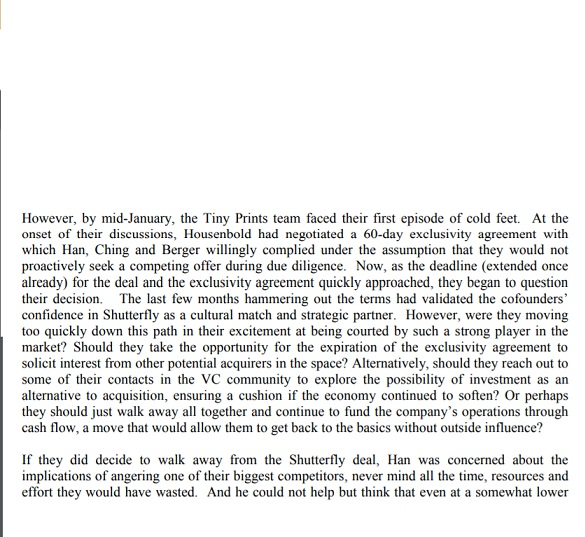
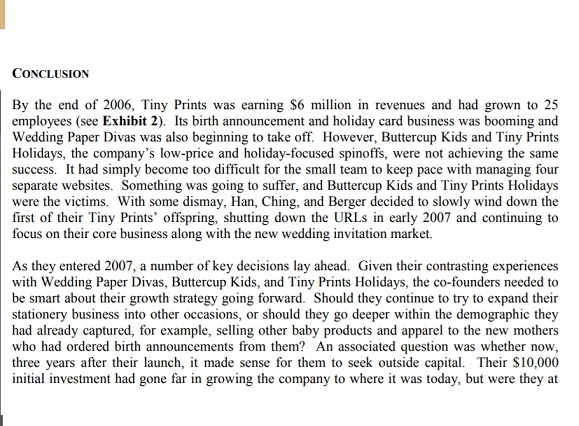
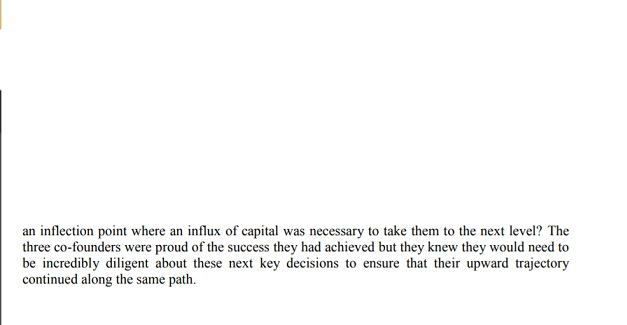
TiNY PRINTS (A) BACKGROUND After two years working for a mobile computing company based in Palo Alto, Califoia, Ed Han was ready for a change. He and several of his classmates from business school had been back in the working world since their graduation in 2000, and as Ed recalled, "We were getting pretty frustrated with the companies where we were working-something was just missing. We also felt this little window, this time when you could start a company without a lot of other responsibilities, beginning to close as people started to get engaged or married and start families.""A group of classmates and friends decided to meet one night a week over burritos at the Mountain View apartment Han shared with another classmate, Eric Chen, to brainstorm ideas for business ventures. Their get-togethers provided not only an excuse to socialize, but a refreshing alternative to their day jobs and an avenue for vetting their ideas. The common goal was to create a successful business with the kind of workplace where everyone was excited to contribute, where people treated each other like family and were united by the passion to win. As the months wore on and enthusiasm waned or circumstances changed, several members of the group were replaced by other friends or work colleagues. The informal brainstorming sessions volved into more structured meetings focused on a specific topic and attendees were assigned "homework" for the subsequent gathering. For example, one of the group's early ideas came about as the airline industry began to phase out free in-flight meals. Their business would provide high-quality meals inside the airport which passengers could take with them on the plane. Individuals were tasked with sizing the market and defining the competitive landscape to determine the viability of such a service-an exercise which convinced them that the market was already too saturated by in-airport restaurant franchises. Over their months together, the group (affectionately dubbed "Pacchetti Partnerds" after the street on which Han and Chen lived), considered dozens of ideas across a breadth of industries, ranging from a local airline between San Francisco and Lake Tahoe to curry and crepe franchises cleverly named "Madame Curry" and "Crepes of Wrath", respectively In early 2003, Kelly Berger joined the group. Berger worked as a product manager at the mobile computing company, Danger, where Han also worked. The two became fast friends at Dange and Han invited him to attend the weekly brainstorming sessions. At the time, the social networking concept was gaining momentum via websites such as Friendster and MySpace. exploring various options for capitalizing on the concept, the group settled on the idea to build a social network connecting alumni from the same university. As the idea with the greatest merit of the many they had evaluated, they decided to dive in head first. While several members defined the site features and look and feel, Berger spent the next few months, on nights and weekends, building the technology backbone to enable photo sharing, status updates and network connections. They launched the beta site to a close group of friends in mid positive initial feedback, the group decided to scrap their concept, largely based on the premise that they would need to raise a significant amount of capital to fully commercialize the product, a task none of them had interest undertaking. After -2003. Despite Both Berger and Han, in particular, had developed a strong aversion to venture capital financing through their years working in industry. From their own observations of the dot-com bubble and their firsthand experience at Danger (which had raised S142 million in venture funding over seven years), they felt that outside capital inevitably created an exit-driven mentality that could force the management team to make choices they might not have otherwise. Furthermore, if the company was not able to achieve its exit in a timely manner, the workforce became demoralized, creating further obstacles to success. Berger and Han both felt strongly that if they were to start a company, they wanted it to be a place where they solely controlled its destiny. As Berger recalled, "We were open to everything from trying to create a billion-dollar company to building nice family business we could pass down to our kids. We just wanted the freedom to create team's skill set lent itself well to an e-commerce start-up, particularly since Han had launched his own e-commerce website prior to business school and helped his wife with another one post- business school With their target defined, the team began to research products which did not yet have a crowded online presence but could take advantage of the many key benefits provided by the online retail model. After a fairly extensive search, they narrowed their focus down to three products: tea Persian rugs, and stationery. Tea was a large and growing market with global appeal; it was light to ship, there was a huge selection available, and the small number of online purveyors meant there were significant opportunities to establish a first mover advantage. Though completely different from tea, Persian rugs proved similarly intriguing. An online presence would allovw consumers to browse and filter thousands of available products (nearly impossible in a physical etting), as well as learn details about each product's origin, design, and unique features. Unlike tea, Persian rugs were cumbersome and expensive to ship. However, their high ticket value meant lower volumes were required to achieve substantive revenues. Ultimately, neither product proved as attractive in their economic or personal appeal as stationery, the group's final choice for their new venture TINY PRINTS IS BORN In the fall of 2003, Han and his wife, Polly, were expecting their first child. One of the group's previous members, Jim, suggested Han's imminent parenthood as a source of idea generation. The market itself -parents having babies-was large, well-defined, and characterized primarily by tired moms who wanted quick and easy solutions to their various needs. The team began to brainstorm ways to aggregate or streamline access to products so as to make them more cost effective and/or easily attainable by new parents. As the Hans thought about the arduous process of selecting baby announcements, the perfect opportunity presented itself The process of selecting baby announcements was relatively basic at the time, starting first with a visit to a stationery store, such as Hallmark, or a specialized local shop where new parents browsed through dozens of catalogs to find a design they liked. They then wrote out the wording for the announcement on a piece of paper which was faxed to the vendor who created a black and hite proof of the announcement. This proof was faxed back and forth between the store and the vendor (often several times) until the final version was approved by the customer. Errors were common, and the process could take several weeks from beginning to end. The team realized that this was exactly the kind of opportunity they had been seeking. An e-commerce solution for In the fall of 2003, Han and his wife, Polly, were expecting their first child. One of the group's previous members, Jim, suggested Han's imminent parenthood as a source of idea generation The market itself parents having babies-was large, well-defined, and characterized primarily by tired moms who wanted quick and easy solutions to their various needs. The team began to brainstorm ways to aggregate or streamline access to products so as to make them more cost effective and/or easily attainable by new parents. As the Hans thought about the arduous process of selecting baby announcements, the perfect opportunity presented itself. The process of selecting baby announcements was relatively basic at the time, starting first with a visit to a stationery store, such as Hallmark, or a specialized local shop where new parents browsed through dozens of catalogs to find a design they liked. They then wrote out the wording for the announcement on a piece of paper which was faxed to the vendor who created a black and white proof of the announcement. This proof was faxed back and forth between the store and the vendor (often several times) until the final version was approved by the customer. Errors were common, and the process could take several weeks from beginning to end. The team realized that this was exactly the kind of opportunity they had been seeking. An e-commerce solution for baby announcements required little capital to start since there was no inventory to speak of, the product was light to ship, there were few competitors at the time and the Hans' experience highlighted the huge opportunities for innovation. Not only could they use emerging technology to customize the product and make the overall process far more efficient, but a successful model would engender brand loyalty and open up the possible opportunity for expansion into other occasions for which customers would want personalized stationery By the end of 2003 when their idea crystallized, the core group had been meeting for a year and a half to brainstorm ideas. Han recalled, "We got to this point where we just said, We're going to do something. We're not even going to write a business plan because this experiment is going to TINY PRINTS (B) Ed Han hung up the phone and quickly gathered his things so he would not be late for his weekly check-in with his two partners, Laura Ching and Kelly Berger. It felt like his phone had not stopped ringing since Tiny Prints wrapped up its blockbuster holiday season at the end of December 2006, just three weeks earlier. The influx of calls from venture capitalists (VCs) and private equity firms had come as somewhat of a surprise, particularly since the company's primary marketing channels to date had been consumer-oriented, represented mainly by celebrity-focused campaigns. In fact, the cofounders had made a concerted effort to stay under the radar and out of the business press while they worked to establish a strong foothold in the market. But the recent slew of calls indicated that word had clearly gotten out Tiny Prints was doing well, and investors were taking notice FORCED TO THINK With 50 percent margins and low capital costs, Tiny Prints had achieved profitability from day one. Han, Ching and Berger had been laser focused on building the brand and expanding the product line, and they were seeing results, with hockey stick revenue growth since their launch and over 50,000 customers to date. However, there was still an incredible amount of work to be done and the demands of running a startup were intense-calls from investors were not necessarily a welcome interruption. As Han explained, "We were going 1,000 miles per hour so we felt that we didn't have a minute for distracting conversations."To properly set expectations, Han told investors up front that he and his partnes were not seeking no were they interested in funding. Investors' response was nearly universal: "That's fine. We just want to Though Han and his partners knew they did not want to seek funding in the near term, outside interest in the company did force the threesome to think through the implications of financing on their future. Shortly after the surge of investor interest came in, Ed was approached by Shutterfly, one of the leading players in the online photo sharing and development space, to discuss a possible merger. Han and his team believed it was too early in their journey to make such a move, but they figured there was some number which would make selling the company a "no brainer As Han recalled, "We shared this 'no brainer number' with the Shutterfly team just to see if they would bite. Not surprisingly, they told us we were crazy balked, the discussion re-confirmed the cofounders' shared vision and commitment to growing their company on their own terms. Now that they were fielding calls from investors, they were comfortable responding with, "Thanks, but no thanks" so they could return to the work of building the Tiny Prints business. ." Though Shutterfly SHUTTERFLY Throughout the spring and summer of 2007, the Tiny Prints team continued intensive product development efforts to gear up for the upcoming holiday season, aiming to meet or beat the 400 percent growth rate they had achieved the prior year. Han checked in quarterly with the 15 to 20 VCs who had reached out in January, with the goal of keeping options open, while maintaining the "not interested right now" stance Like the investors, Shutterfly was also tracking Tiny Prints' stellar growth, impressed by the fact that the company CEO, Jeffrey Housenbold, called up Han in October of 2007 to congratulate him on the company's success and propose they get together once again. This time, Housenbold suggested the companies take the time to get to know one another in more depth. He believed Shutterfly's tight-knit culture and core values would resonate with the Tiny Prints cofounders, amplifying the obvious synergy between the two companies had indeed gained the traction the founders claimed it would. Shutterfly's Getting to Know You After several successful "get to know you" meetings between the Tiny Prints cofounders, their new COO, Mak Azadi, and key members of the Shutterfly team, Housenbold opened up the valuation discussion. Han, Ching, Berger and Azadi were extremely pleased to find what a difference just eight short months had made. Shutterfly's number, based on the Tiny Print's target of $20 million in revenues for 2007, was incredibly compelling and marked the first time Getting to Know You After several successful "get to know you" meetings between the Tiny Prints cofounders, their new COO, Mak Azadi, and key members of the Shutterfly team, Housenbold opened up the valuation discussion. Han, Ching, Berger and Azadi were extremely pleased to find what a difference just eight short months had made. Shutterfly's number, based on the Tiny Print's target of $20 million in revenues for 2007, was incredibly compelling and marked the first time an outside party had put forth a real valuation. Han reflected on his thoughts at the time, "We were definitely caught up in the flattery and the financial upside, and so were willing to explore what a potenial con might mean. As soon as the Shutterfly team got the signal that Tiny Prints was interested, it dove into an "all in" due diligence effort that would subsequently take up the majority of Han, Ching and Berger's time throughout the fall of 2007. They soon found themselves wading through a due diligence paper storm, which mandated that they hire a boutique banker out of Seattle (a firm Azadi had Though at times tedious and lengthy, Han, Ching, Berger and Azadi found the negotiations with Shutterfly generally cordial and efficient. Disagreements were challenges navigated quickly. As both companies approached the holiday season, they were doubly motivated to come to a mutually attractive agreement since both sides would need to return their focus to business operations during this busiest time of year. By mid two sides had settled on a valuation, under the agreement t currency to pay for a portion of the total, with the balance paid in cash hammered out smoothly and -December, the hat Shutterfly would use their stock as A New Year and a New Outlook After an incredibly busy but successful holiday season, the Tiny Prints and Shutterfly teams reunited to finalize the deal. The hardest part was done -all of the terms of the agreement, down to the most minute detail, had been nailed down. At this point, it was simply a matter of Shutterfly ironing out the mechanisms for financing the deal. Though seemingly straightforward, this process was complicated by the fact that Shutterfly's stock had begun ticking down in value, ever so slightly, since late in 2007, a general trend seen in the stock market as a whole. Regardless, Housenbold and his team were proactive in coming up with creative solutions to continue to make the valuation as attractive as possible for Tiny Prints' cofounders. Han was not worried. As he explained, "We had put so much time and effort into the process and had built such a strong relationship with the Shutterfly folks that we just took the attitude We are committed to building a great company together. We can make this work'." However, by mid-January, the Tiny Prints team faced their first episode of cold feet. At the onset of their discussions, Housenbold had negotiated a 60-day exclusivity agreement with which Han, Ching and Berger willingly complied under the assumption that they would not proactively seek a competing offer during due diligence. Now, as the deadline (extended once already) for the deal and the exclusivity agreement quickly approached, they began to question their decision. The last few months hammering out the terms had validated the cofounders' confidence in Shutterfly as a cultural match and strategic partner. However, were they moving too quickly down this path in their excitement at being courted by such a strong player in the market? Should they take the opportunity for the expiration of the exclusivity agreement to solicit interest from other potential acquirers in the space? Alternatively, should they reach out to some of their contacts in the VC community to explore the possibility of investment as an alternative to acquisition, ensuring a cushion if the economy continued to soften? Or perhaps they should just walk away all together and continue to fund the company's operations through cash flow, a move that would allow them to get back to the basics without outside influence? If they did decide to walk away from the Shutterfly deal, Han was concerned about the implications of angering one of their biggest competitors, never mind all the time, resources and effort they would have wasted. And he could not help but think that even at a somewhat lower CONCLUSION By the end of 2006, Tiny Prints was earning $6 million in revenues and had grown to 25 employees (see Exhibit 2). Its birth announcement and holiday card business was booming and Wedding Paper Divas was also beginning to take off. However, Buttercup Kids and Tiny Prints Holidays, the company's low-price and holiday-focused spinoffs, were not achieving the same success. It had simply become too difficult for the small team to keep pace with managing four separate websites. Something was going to suffer, and Buttercup Kids and Tiny Prints Holidays were the victims. With some dismay, Han, Ching, and Berger decided to slowly wind down the first of their Tiny Prints offspring, shutting down the URLs in early 2007 and continuing to focus on their core business along with the new wedding invitation market. As they entered 2007, a number of key decisions lay ahead. Given their contrasting experiences with Wedding Paper Divas, Buttercup Kids, and Tiny Prints Holidays, the co-founders needed to be smart about their growth strategy going forward. Should they continue to try to expand their stationery business into other occasions, or should the had already captured, for example, selling other baby products and apparel to the new mothers who had ordered birth announcements from them? An associated question was whether now three years after their launch, it made sense for them to seek outside capital. Their $10,000 initial investment had gone far in growing the company to where it was today, but were they at y go deeper within the demographic they an inflection point where an influx of capital was necessary to take them to the next level? The three co-founders were proud of the success they had achieved but they knew they would need to be incredibly diligent about these next key decisions to ensure that their upward trajectory continued along the same path. TiNY PRINTS (A) BACKGROUND After two years working for a mobile computing company based in Palo Alto, Califoia, Ed Han was ready for a change. He and several of his classmates from business school had been back in the working world since their graduation in 2000, and as Ed recalled, "We were getting pretty frustrated with the companies where we were working-something was just missing. We also felt this little window, this time when you could start a company without a lot of other responsibilities, beginning to close as people started to get engaged or married and start families.""A group of classmates and friends decided to meet one night a week over burritos at the Mountain View apartment Han shared with another classmate, Eric Chen, to brainstorm ideas for business ventures. Their get-togethers provided not only an excuse to socialize, but a refreshing alternative to their day jobs and an avenue for vetting their ideas. The common goal was to create a successful business with the kind of workplace where everyone was excited to contribute, where people treated each other like family and were united by the passion to win. As the months wore on and enthusiasm waned or circumstances changed, several members of the group were replaced by other friends or work colleagues. The informal brainstorming sessions volved into more structured meetings focused on a specific topic and attendees were assigned "homework" for the subsequent gathering. For example, one of the group's early ideas came about as the airline industry began to phase out free in-flight meals. Their business would provide high-quality meals inside the airport which passengers could take with them on the plane. Individuals were tasked with sizing the market and defining the competitive landscape to determine the viability of such a service-an exercise which convinced them that the market was already too saturated by in-airport restaurant franchises. Over their months together, the group (affectionately dubbed "Pacchetti Partnerds" after the street on which Han and Chen lived), considered dozens of ideas across a breadth of industries, ranging from a local airline between San Francisco and Lake Tahoe to curry and crepe franchises cleverly named "Madame Curry" and "Crepes of Wrath", respectively In early 2003, Kelly Berger joined the group. Berger worked as a product manager at the mobile computing company, Danger, where Han also worked. The two became fast friends at Dange and Han invited him to attend the weekly brainstorming sessions. At the time, the social networking concept was gaining momentum via websites such as Friendster and MySpace. exploring various options for capitalizing on the concept, the group settled on the idea to build a social network connecting alumni from the same university. As the idea with the greatest merit of the many they had evaluated, they decided to dive in head first. While several members defined the site features and look and feel, Berger spent the next few months, on nights and weekends, building the technology backbone to enable photo sharing, status updates and network connections. They launched the beta site to a close group of friends in mid positive initial feedback, the group decided to scrap their concept, largely based on the premise that they would need to raise a significant amount of capital to fully commercialize the product, a task none of them had interest undertaking. After -2003. Despite Both Berger and Han, in particular, had developed a strong aversion to venture capital financing through their years working in industry. From their own observations of the dot-com bubble and their firsthand experience at Danger (which had raised S142 million in venture funding over seven years), they felt that outside capital inevitably created an exit-driven mentality that could force the management team to make choices they might not have otherwise. Furthermore, if the company was not able to achieve its exit in a timely manner, the workforce became demoralized, creating further obstacles to success. Berger and Han both felt strongly that if they were to start a company, they wanted it to be a place where they solely controlled its destiny. As Berger recalled, "We were open to everything from trying to create a billion-dollar company to building nice family business we could pass down to our kids. We just wanted the freedom to create team's skill set lent itself well to an e-commerce start-up, particularly since Han had launched his own e-commerce website prior to business school and helped his wife with another one post- business school With their target defined, the team began to research products which did not yet have a crowded online presence but could take advantage of the many key benefits provided by the online retail model. After a fairly extensive search, they narrowed their focus down to three products: tea Persian rugs, and stationery. Tea was a large and growing market with global appeal; it was light to ship, there was a huge selection available, and the small number of online purveyors meant there were significant opportunities to establish a first mover advantage. Though completely different from tea, Persian rugs proved similarly intriguing. An online presence would allovw consumers to browse and filter thousands of available products (nearly impossible in a physical etting), as well as learn details about each product's origin, design, and unique features. Unlike tea, Persian rugs were cumbersome and expensive to ship. However, their high ticket value meant lower volumes were required to achieve substantive revenues. Ultimately, neither product proved as attractive in their economic or personal appeal as stationery, the group's final choice for their new venture TINY PRINTS IS BORN In the fall of 2003, Han and his wife, Polly, were expecting their first child. One of the group's previous members, Jim, suggested Han's imminent parenthood as a source of idea generation. The market itself -parents having babies-was large, well-defined, and characterized primarily by tired moms who wanted quick and easy solutions to their various needs. The team began to brainstorm ways to aggregate or streamline access to products so as to make them more cost effective and/or easily attainable by new parents. As the Hans thought about the arduous process of selecting baby announcements, the perfect opportunity presented itself The process of selecting baby announcements was relatively basic at the time, starting first with a visit to a stationery store, such as Hallmark, or a specialized local shop where new parents browsed through dozens of catalogs to find a design they liked. They then wrote out the wording for the announcement on a piece of paper which was faxed to the vendor who created a black and hite proof of the announcement. This proof was faxed back and forth between the store and the vendor (often several times) until the final version was approved by the customer. Errors were common, and the process could take several weeks from beginning to end. The team realized that this was exactly the kind of opportunity they had been seeking. An e-commerce solution for In the fall of 2003, Han and his wife, Polly, were expecting their first child. One of the group's previous members, Jim, suggested Han's imminent parenthood as a source of idea generation The market itself parents having babies-was large, well-defined, and characterized primarily by tired moms who wanted quick and easy solutions to their various needs. The team began to brainstorm ways to aggregate or streamline access to products so as to make them more cost effective and/or easily attainable by new parents. As the Hans thought about the arduous process of selecting baby announcements, the perfect opportunity presented itself. The process of selecting baby announcements was relatively basic at the time, starting first with a visit to a stationery store, such as Hallmark, or a specialized local shop where new parents browsed through dozens of catalogs to find a design they liked. They then wrote out the wording for the announcement on a piece of paper which was faxed to the vendor who created a black and white proof of the announcement. This proof was faxed back and forth between the store and the vendor (often several times) until the final version was approved by the customer. Errors were common, and the process could take several weeks from beginning to end. The team realized that this was exactly the kind of opportunity they had been seeking. An e-commerce solution for baby announcements required little capital to start since there was no inventory to speak of, the product was light to ship, there were few competitors at the time and the Hans' experience highlighted the huge opportunities for innovation. Not only could they use emerging technology to customize the product and make the overall process far more efficient, but a successful model would engender brand loyalty and open up the possible opportunity for expansion into other occasions for which customers would want personalized stationery By the end of 2003 when their idea crystallized, the core group had been meeting for a year and a half to brainstorm ideas. Han recalled, "We got to this point where we just said, We're going to do something. We're not even going to write a business plan because this experiment is going to TINY PRINTS (B) Ed Han hung up the phone and quickly gathered his things so he would not be late for his weekly check-in with his two partners, Laura Ching and Kelly Berger. It felt like his phone had not stopped ringing since Tiny Prints wrapped up its blockbuster holiday season at the end of December 2006, just three weeks earlier. The influx of calls from venture capitalists (VCs) and private equity firms had come as somewhat of a surprise, particularly since the company's primary marketing channels to date had been consumer-oriented, represented mainly by celebrity-focused campaigns. In fact, the cofounders had made a concerted effort to stay under the radar and out of the business press while they worked to establish a strong foothold in the market. But the recent slew of calls indicated that word had clearly gotten out Tiny Prints was doing well, and investors were taking notice FORCED TO THINK With 50 percent margins and low capital costs, Tiny Prints had achieved profitability from day one. Han, Ching and Berger had been laser focused on building the brand and expanding the product line, and they were seeing results, with hockey stick revenue growth since their launch and over 50,000 customers to date. However, there was still an incredible amount of work to be done and the demands of running a startup were intense-calls from investors were not necessarily a welcome interruption. As Han explained, "We were going 1,000 miles per hour so we felt that we didn't have a minute for distracting conversations."To properly set expectations, Han told investors up front that he and his partnes were not seeking no were they interested in funding. Investors' response was nearly universal: "That's fine. We just want to Though Han and his partners knew they did not want to seek funding in the near term, outside interest in the company did force the threesome to think through the implications of financing on their future. Shortly after the surge of investor interest came in, Ed was approached by Shutterfly, one of the leading players in the online photo sharing and development space, to discuss a possible merger. Han and his team believed it was too early in their journey to make such a move, but they figured there was some number which would make selling the company a "no brainer As Han recalled, "We shared this 'no brainer number' with the Shutterfly team just to see if they would bite. Not surprisingly, they told us we were crazy balked, the discussion re-confirmed the cofounders' shared vision and commitment to growing their company on their own terms. Now that they were fielding calls from investors, they were comfortable responding with, "Thanks, but no thanks" so they could return to the work of building the Tiny Prints business. ." Though Shutterfly SHUTTERFLY Throughout the spring and summer of 2007, the Tiny Prints team continued intensive product development efforts to gear up for the upcoming holiday season, aiming to meet or beat the 400 percent growth rate they had achieved the prior year. Han checked in quarterly with the 15 to 20 VCs who had reached out in January, with the goal of keeping options open, while maintaining the "not interested right now" stance Like the investors, Shutterfly was also tracking Tiny Prints' stellar growth, impressed by the fact that the company CEO, Jeffrey Housenbold, called up Han in October of 2007 to congratulate him on the company's success and propose they get together once again. This time, Housenbold suggested the companies take the time to get to know one another in more depth. He believed Shutterfly's tight-knit culture and core values would resonate with the Tiny Prints cofounders, amplifying the obvious synergy between the two companies had indeed gained the traction the founders claimed it would. Shutterfly's Getting to Know You After several successful "get to know you" meetings between the Tiny Prints cofounders, their new COO, Mak Azadi, and key members of the Shutterfly team, Housenbold opened up the valuation discussion. Han, Ching, Berger and Azadi were extremely pleased to find what a difference just eight short months had made. Shutterfly's number, based on the Tiny Print's target of $20 million in revenues for 2007, was incredibly compelling and marked the first time Getting to Know You After several successful "get to know you" meetings between the Tiny Prints cofounders, their new COO, Mak Azadi, and key members of the Shutterfly team, Housenbold opened up the valuation discussion. Han, Ching, Berger and Azadi were extremely pleased to find what a difference just eight short months had made. Shutterfly's number, based on the Tiny Print's target of $20 million in revenues for 2007, was incredibly compelling and marked the first time an outside party had put forth a real valuation. Han reflected on his thoughts at the time, "We were definitely caught up in the flattery and the financial upside, and so were willing to explore what a potenial con might mean. As soon as the Shutterfly team got the signal that Tiny Prints was interested, it dove into an "all in" due diligence effort that would subsequently take up the majority of Han, Ching and Berger's time throughout the fall of 2007. They soon found themselves wading through a due diligence paper storm, which mandated that they hire a boutique banker out of Seattle (a firm Azadi had Though at times tedious and lengthy, Han, Ching, Berger and Azadi found the negotiations with Shutterfly generally cordial and efficient. Disagreements were challenges navigated quickly. As both companies approached the holiday season, they were doubly motivated to come to a mutually attractive agreement since both sides would need to return their focus to business operations during this busiest time of year. By mid two sides had settled on a valuation, under the agreement t currency to pay for a portion of the total, with the balance paid in cash hammered out smoothly and -December, the hat Shutterfly would use their stock as A New Year and a New Outlook After an incredibly busy but successful holiday season, the Tiny Prints and Shutterfly teams reunited to finalize the deal. The hardest part was done -all of the terms of the agreement, down to the most minute detail, had been nailed down. At this point, it was simply a matter of Shutterfly ironing out the mechanisms for financing the deal. Though seemingly straightforward, this process was complicated by the fact that Shutterfly's stock had begun ticking down in value, ever so slightly, since late in 2007, a general trend seen in the stock market as a whole. Regardless, Housenbold and his team were proactive in coming up with creative solutions to continue to make the valuation as attractive as possible for Tiny Prints' cofounders. Han was not worried. As he explained, "We had put so much time and effort into the process and had built such a strong relationship with the Shutterfly folks that we just took the attitude We are committed to building a great company together. We can make this work'." However, by mid-January, the Tiny Prints team faced their first episode of cold feet. At the onset of their discussions, Housenbold had negotiated a 60-day exclusivity agreement with which Han, Ching and Berger willingly complied under the assumption that they would not proactively seek a competing offer during due diligence. Now, as the deadline (extended once already) for the deal and the exclusivity agreement quickly approached, they began to question their decision. The last few months hammering out the terms had validated the cofounders' confidence in Shutterfly as a cultural match and strategic partner. However, were they moving too quickly down this path in their excitement at being courted by such a strong player in the market? Should they take the opportunity for the expiration of the exclusivity agreement to solicit interest from other potential acquirers in the space? Alternatively, should they reach out to some of their contacts in the VC community to explore the possibility of investment as an alternative to acquisition, ensuring a cushion if the economy continued to soften? Or perhaps they should just walk away all together and continue to fund the company's operations through cash flow, a move that would allow them to get back to the basics without outside influence? If they did decide to walk away from the Shutterfly deal, Han was concerned about the implications of angering one of their biggest competitors, never mind all the time, resources and effort they would have wasted. And he could not help but think that even at a somewhat lower CONCLUSION By the end of 2006, Tiny Prints was earning $6 million in revenues and had grown to 25 employees (see Exhibit 2). Its birth announcement and holiday card business was booming and Wedding Paper Divas was also beginning to take off. However, Buttercup Kids and Tiny Prints Holidays, the company's low-price and holiday-focused spinoffs, were not achieving the same success. It had simply become too difficult for the small team to keep pace with managing four separate websites. Something was going to suffer, and Buttercup Kids and Tiny Prints Holidays were the victims. With some dismay, Han, Ching, and Berger decided to slowly wind down the first of their Tiny Prints offspring, shutting down the URLs in early 2007 and continuing to focus on their core business along with the new wedding invitation market. As they entered 2007, a number of key decisions lay ahead. Given their contrasting experiences with Wedding Paper Divas, Buttercup Kids, and Tiny Prints Holidays, the co-founders needed to be smart about their growth strategy going forward. Should they continue to try to expand their stationery business into other occasions, or should the had already captured, for example, selling other baby products and apparel to the new mothers who had ordered birth announcements from them? An associated question was whether now three years after their launch, it made sense for them to seek outside capital. Their $10,000 initial investment had gone far in growing the company to where it was today, but were they at y go deeper within the demographic they an inflection point where an influx of capital was necessary to take them to the next level? The three co-founders were proud of the success they had achieved but they knew they would need to be incredibly diligent about these next key decisions to ensure that their upward trajectory continued along the same path


















